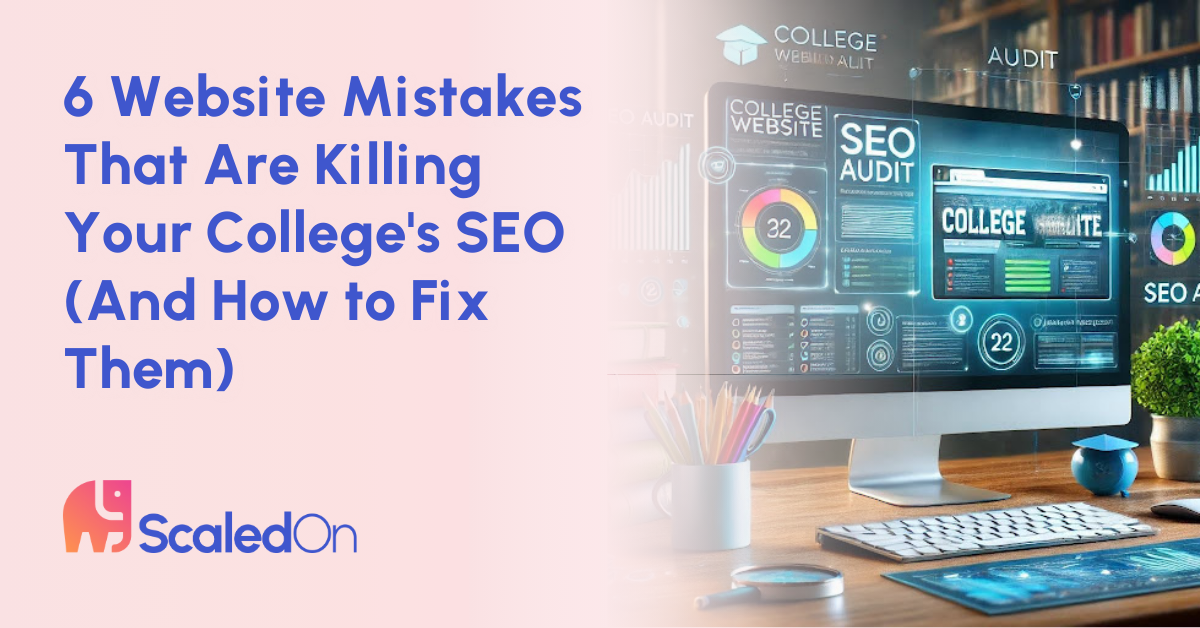Is your college website holding back your online potential? Our checklist, “6 Website Mistakes That Are Killing Your College’s SEO (And How to Fix Them),” dives into common pitfalls like outdated design, technical issues, and missed local SEO opportunities. Packed with actionable tips for a comprehensive education website audit, this guide will help you master college website optimization and attract more students while improving your search rankings. Don’t let simple mistakes hinder your success—start optimizing today!
Maintaining a strong online presence is essential for colleges and universities to attract new students, retain current ones, and engage alumni. But what if your website is inadvertently driving people (and search engines) away? Let’s tackle six common mistakes that could be killing your college’s SEO, with actionable tips to fix them.
Ready? Let’s start your education website audit with this friendly, SEO-packed checklist.
Table of Contents
Mistake 1: Ignoring Mobile Optimization 📱
Why It Matters:
More than 60% of web traffic comes from mobile devices. If your site isn’t mobile-friendly, you’re alienating prospective students, parents, and Google’s algorithms.
Checklist to Fix It:
- Run a Mobile-Friendliness Test: Use Google’s free tool to identify problem areas on your site.
- Adopt Responsive Design: Ensure your site adjusts dynamically to fit any screen size.
- Simplify Navigation: Create a clean, user-friendly menu that’s easy to use on smaller screens.
- Optimize Page Speed for Mobile: Compress images, enable caching, and minimize code to reduce load times.
- Test Frequently on Different Devices: Check how your site looks and functions across various smartphones and tablets.
Mistake 2: Outdated or Slow Website Design 🕒

Why It Matters:
Your website is often a student’s first impression of your college. A clunky or outdated design can send the wrong message and impact your search rankings.
Checklist to Fix It:
- Evaluate Your Design Regularly: Conduct a design audit to ensure your site stays modern and visually appealing.
- Streamline UX: Make vital sections like admissions, programs, and FAQs easy to access.
- Improve Load Times: Use tools like PageSpeed Insights to identify what’s slowing you down.
- Upgrade Hosting: Invest in a hosting provider that offers fast load speeds and reliable uptime.
- Keep Content Updated: Refresh your homepage, blogs, and news sections regularly.
Mistake 3: Neglecting Technical SEO 🛠️
Why It Matters:
Technical SEO lays the foundation for search engines to understand and rank your site. Overlooking this can make even the best content invisible.
Checklist to Fix It:
- Conduct Regular Site Audits: Use tools like Screaming Frog or Ahrefs to spot technical issues.
- Fix Broken Links: Redirect or repair broken links that frustrate users and hurt rankings.
- Submit an XML Sitemap: Help search engines find and index all your important pages.
- Address Duplicate Content: Avoid publishing repetitive content that confuses search engines.
- Enhance Internal Linking: Strategically link between pages to improve site navigation and authority.
- Optimize Metadata: Ensure all pages have unique and keyword-rich meta titles and descriptions.\n
Mistake 4: Ignoring Local SEO 📍
Why It Matters:
Many students and parents search for “colleges near me” or similar terms. Failing to optimize for local search can mean missing out on these highly targeted leads.
Checklist to Fix It:
- Claim and Optimize Google My Business: Keep your profile up-to-date with accurate contact info, images, and reviews.
- Incorporate Local Keywords: Use phrases like “top colleges in [city/state]” in your content.
- Encourage Reviews: Ask current students and alumni to leave positive reviews on Google, Yelp, or niche platforms.
- Add Local Schema Markup: Highlight your institution’s location for better search engine understanding.
- Get Listed in Directories: Submit your site to educational and local directories for additional backlinks.
Mistake 5: Poor Content Strategy 📝

Why It Matters:
Content is the cornerstone of SEO. Without a solid strategy, your site might struggle to rank for relevant keywords and fail to engage visitors.
Checklist to Fix It:
- Know Your Audience: Create content that speaks to prospective students, parents, and faculty.
- Plan Content in Advance: Develop a content calendar for blogs, videos, and updates.
- Focus on Evergreen Content: Write about lasting topics like “how to apply for financial aid” or “choosing a major.”
- Optimize for Keywords: Use terms like “education website audit” and “college website optimization” naturally within your content.
- Diversify Content Types: Mix blogs, infographics, videos, and webinars to appeal to different audiences.
- Analyze Performance: Use analytics tools to see which content performs well and iterate on it.
Mistake 6: Not Leveraging Analytics and Data 📊
Why It Matters:
If you’re not tracking your performance, you’re missing valuable insights that can guide your SEO strategy and website improvements.
Checklist to Fix It:
- Set Up Google Analytics: Monitor visitor behavior, traffic sources, and engagement metrics.
- Use Google Search Console: Identify indexing errors, search performance, and more.
- Track Keyword Rankings: Use tools like SEMrush to see how your targeted keywords are performing.
- Monitor Competitors: Analyze what similar colleges are doing to stay ahead.
- Set Clear KPIs: Define measurable goals like reducing bounce rates or increasing applications.
- Review Reports Regularly: Use data insights to fine-tune your strategy and achieve better results.
Wrapping It Up: Let’s Work Together 💡
Feeling a little overwhelmed by all these SEO tasks? You’re not alone. Keeping up with modern SEO trends and technical maintenance can be challenging, especially when your team has other priorities.
But here’s the good news: we’re here to help. At ScaledOn, we specialize in education website audits and college website optimization. Whether you need a quick fix or a full overhaul, we’ve got the expertise to elevate your online presence.
Contact us today, and let’s ensure your website reflects the excellence of your institution. Together, we’ll make your college website a top performer. 🚀
DOWNLOAD PDF CHECKLIST
